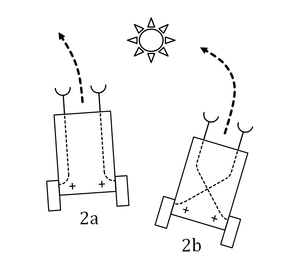CYBERNETIC CREATURES–BRAITENBERG–VEHICLES



In the 1980s, Valentino Braitenberg picked up the concerns of Grey Walter and Ross Ashby and built a series of cybernetic creatures he called “vehicles”. Starting with basic principles (a trolly seeking light), each subsequent vehicle grew in complexity. In a short time these machines exhibited complex behaviour. Braitenberg notes that these machines comply to his "law of uphill analysis and downhill invention", supporting the notion that adaptation constitutes a performative interplay between the environment and the machine-organism within that environment.
EXTRACT:
|...| Researchgate. On Braitenberg’s Vehicles
Extract from Researchgate: “The four basic Braitenberg vehicles [see lower image in margin of this text] can demonstrate useful behavior towards a light source from very simple connection schemes. The arcs at the front of the vehicles are sensors. The sensors connect to the drive units through connections that may be crossed or uncrossed, excitory (+) or inhibitory (-). The labeled emotions are terms Braitenberg uses to describe the reaction of the vehicles towards the light. The arrows display the motion of the vehicles, with the width of the arrow indicating the speed.” [1]
ANNOTATION:
|...| John Johnston. The Allure of Machinic Life: Cybernetics, Artificial Life and the New AI. Cambridge: MIT Press, 2008
Johnston stresses the materiality of cybernetics – All messages have carriers and these are specific to a particular apparatus and systems they work with in (or generate). It is a mistake to speak of “dematerialization”, (other than as a vehicle for non-materialist ideology)[2]
AI and Computation
AI researchers Allen Newell & Herbert A Simon, disparaged the cybernetic creatures – Norbert Wiener’s bed-bug and Grey Walter’s the tortoise – regarding artificial intelligence to be primarily a computational issue. Johnston maintains, "The birth of AI was also the birth of cognitive psychology" In the discourse of AI, it was not a matter of mind but a matter of psychology and processing power. Note: This approach was initiated by McCulloch and Von Neumann, who made an analogy between the off-on function of neutrons and the on-off (absent-present) function of information processed by a computer (see Play Like an Idiot).
"Allen Newell & Herbert A Simon reduced AI to software and re-installed a Cartesian duality which cybernetics had transcended" [3]
Braitenberg’s Vehicles
Working against this trend the neuroscientists favouring AI, Valentino Braitenberg constructed a series of performative machines which had a hierarchy of functions. Braitenberg published accounts of his experiments in Vehicles:experiments in synthetic psychology[4]
Bratengerg established the "law of uphill analysis and downhill invention" which sates it is easier to make a performative, cybernetic devices which do unexpected things than to analise the internal functions that make such behavior possible. " Induction is slow and requires the search for solutions". [5]
In the hierarchy of vehicles – which pick up the principles established in the 1950s by Gray Walter’s experiments with the Tortoise – Vehicle 12 exhibits "FREE WILL" [...] which means "above a certain number of active elements and cross-connections in the vehicle's brain, its behavior becomes unpredictable to the human observer, even though that behavior is completely determined."
This is, Braitenberg suggests, how the brain works and is the basis of our own pride and our autonomy. Vehicle 6 produced by "unconscious engineering" This mimics reproduction by copying vehicles quickly, leading to malfunction or unpredicted improvement (unpredictable outcomes, which mirror the mutations which occur in natural selection). Note: we see from Braitenberg's diagrams (in the margin of this text)that the variation of behaviour is akin to the differences exhibited by the Wiener's bed-bug and the Grey Walter's tortoise . depending on where one laced the light sensor, a different form of behaviour – the tortoise was "ruminative", the bed-bug was "neurotic"(see The Body in Pieces). [6]
- ↑ https://www.researchgate.net
- ↑ Johnston, The Allure of Machinic Life: Cybernetics, Artificial Life and the New AICambridge: MIT Press, 2008, p.60
- ↑ Johnston, The Allure of Machinic Life: Cybernetics, Artificial Life and the New AI p.60; see also, Allen Newell & Herbert A Simon Human Problem Solving. Prentice-Hall, Englewood Cliffs, NJ, USA, 1972.
- ↑ Valentino Braitenberg Vehicles:experiments in synthetic psychology MIT, 1986
- ↑ Johnston, The Allure of Machinic Life: Cybernetics, Artificial Life and the New AI p.63
- ↑ For a formal analysis of Braitenberg’s vehicles 2 and 3 see: Inaki Rano: A Model and Formal Analysis of Braitenberg Vehicles 2 and 3. 2012. IEEE International Conference on Robotics and Automation RiverCentre, Saint Paul, Minnesota, USA May 14-18, 2012